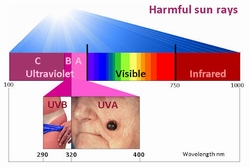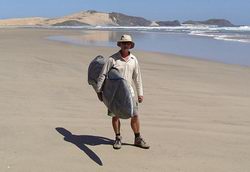There’s a problem about sun protection;
1. We know Ultraviolet rays harm us.
2. But we’re uneasy about sun lotions.
Unfortunately, both points are correct. We hear lines like “your skin absorbs up to 9% of what you rub on it.” Or this little beauty, “don’t rub on your skin what you wouldn’t eat.”
Let’s start with the fact that many sun lotion containers mislead you. Go into any pharmacy, and you can read labels like, “SPF 30+ UVA and UVB protection.”
To understate the case, you could be excused for thinking the lotion has an SPF 30 rating for protection from UVA and UVB rays.
Wrong. SPF only measures UVB. It doesn’t rate UVA.
Okay, but what’s the deal over that?
 Simple. 98% of Ultraviolet rays reaching us are UVA. And while there is overlap, to sum it up, think uvB for Burn, and uvA for cAncer and Aging. This diagram might help.
Simple. 98% of Ultraviolet rays reaching us are UVA. And while there is overlap, to sum it up, think uvB for Burn, and uvA for cAncer and Aging. This diagram might help.
Many sun rays come at us, and the short wavelength ones are the most harmful. As an analogy, think of ocean waves. Imagine a beach with waves hitting every single second. That would destroy the beach in no time. UVC ray waves are like that, and would quickly kill us. Fortunately our atmosphere blocks all UVC rays. But don’t sunbathe on the moon if you ever get there.
New Zealands famous ozone hole lets through more UVB rays than elsewhere. That’s how come we burn faster than say, in Greece. UVA is a wider spectrum ranging from 320-400nm wavelength. UVA rays go deeper into our epidermis, messing with our DNA.
Broad Spectrum
More sophisticated suppliers of sunscreen acknowledge the SPF problem, and include additives that provide UVA coverage. In fact the joint ANZ regulations have various tests that manufacturers can comply with. In Australia suppliers must comply, but here in New Zealand, they are only recommended to comply. (that’s another story, and we’ll get there in a later issue)
However, there is no way of knowing how effective the UVA protection is. There is no official measurement scheme for UVA protection.
 Finally, most broad coverage schemes only apply to the first part of the UVA bandwith. Even the aging ANZ regulations indicate this, only requiring testing to be done on the UVA2 part of the wavelength.
Finally, most broad coverage schemes only apply to the first part of the UVA bandwith. Even the aging ANZ regulations indicate this, only requiring testing to be done on the UVA2 part of the wavelength.
Help might be on the way
The powerful Food and Drug Administration (FDA) in the USA tends to be the real pulse about what is going on. The FDA has talked about upgrading SPF for decades, but nothing has happened yet. Consumer groups smell a conspiracy here, funded by the sunscreen suppliers. And while it is interesting that a billion dollar lawsuit was lodged in 2006 against seven global manufacturers, we won’t go there today. (Although I do love the invective humour of the lawyers; “the only thing being blocked here is the truth!”)
If the FDA proposals proceed in the timeframe suggested, the USA might have a sunscreen measurement scale for UVA by February 2009. I’m not going to predict whether ANZ will then review their 1998 regulations.
But it does make me feel the sunscreen I will use this very summer, is actually inadequate.
What to do?
 Two words of advice beyond the tired slip, slop, slap and wrap campaign of our own Cancer Society.
Two words of advice beyond the tired slip, slop, slap and wrap campaign of our own Cancer Society.
1. Think like a surfer. I’m an aging one, which is a sort of qualification, since I have survived. We go to the beach in the morning, when the sea is glassy, and there is no wind. This is a low UV time of day. 7-10am is the most enjoyable time – no crowds, hoonfree, and the water is just as warm. The lifeguards are usually out by then as well. The worst UV time is 10am – 2pm. Surfers are home by then, avoiding that sand blowing, sandwich gritting, onshore breeze, building the deck their wives want. (See, it’s even good for your relationship!) You can often go back late afternoon when the wind dies.
2. Think clothing as an alternative to lotion. Discover the world of UV fabric protection and breathable shirts. At our age, while clothing ought to look good, function and comfort tend to mean more, compared to Generation Why.
Next issue: Just what are those sunscreen chemicals?









- 8 years ago
Hi Lyne67529
Thanks for the feedback, we’ve updated the link so it’s working now.